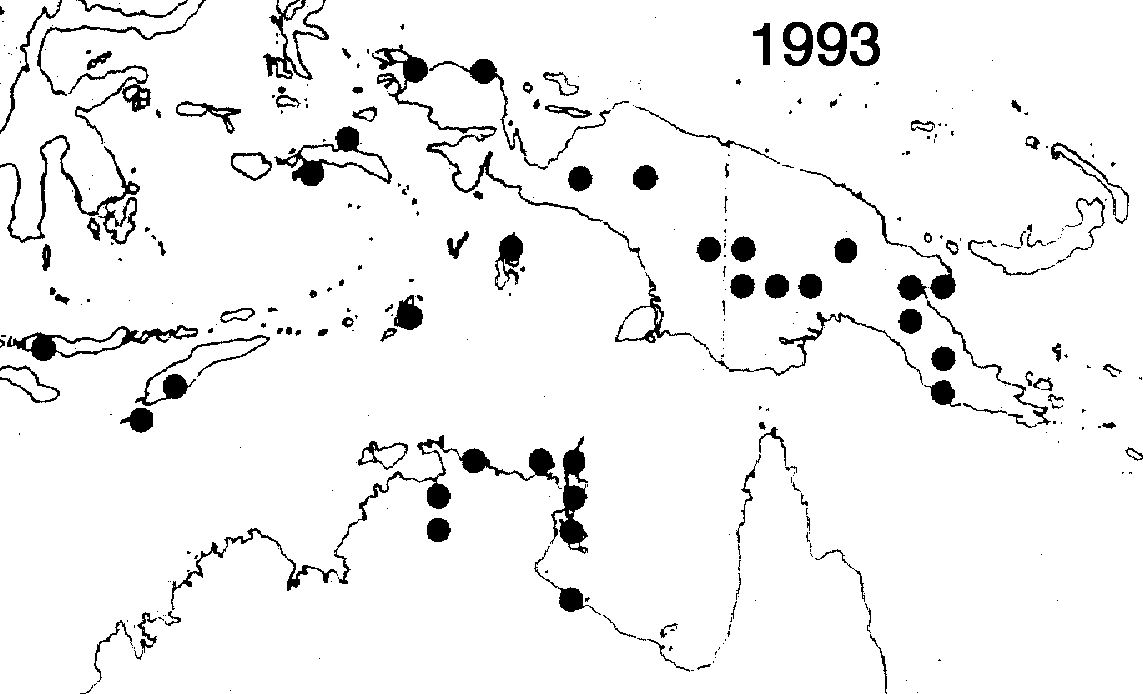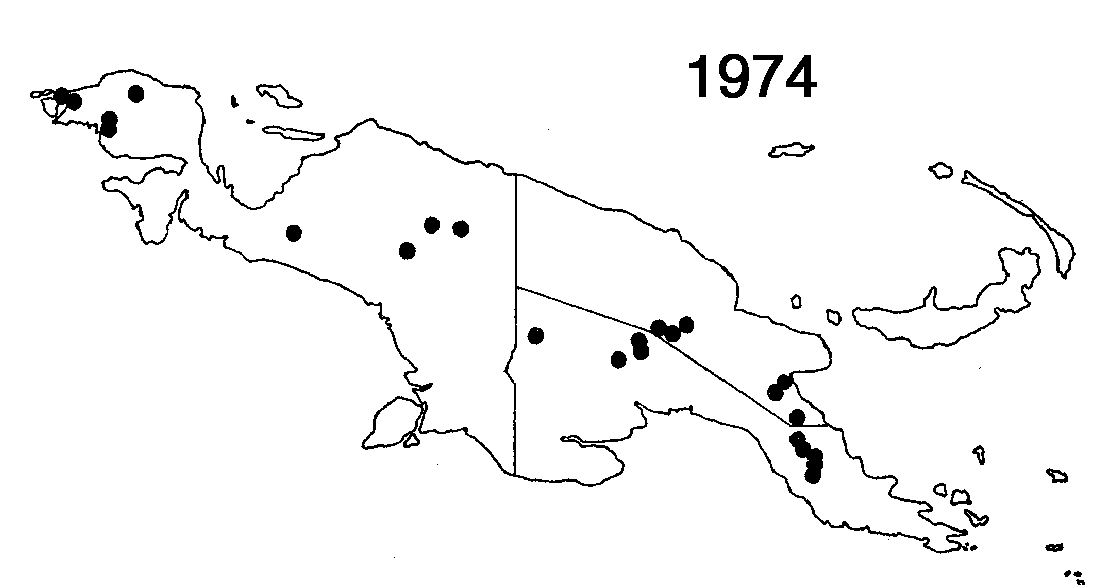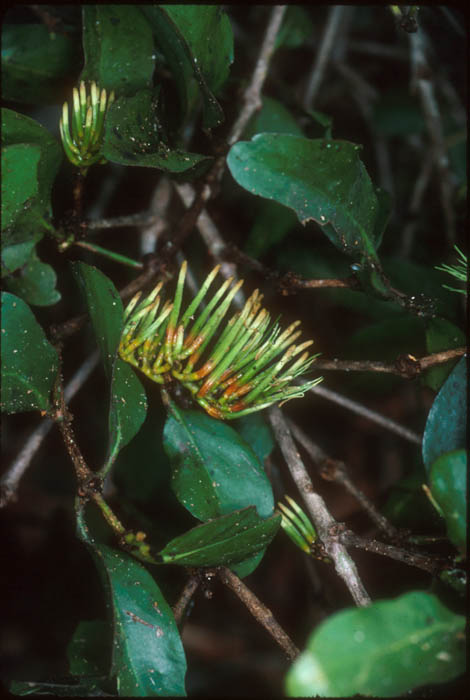
Distribution Maps


Decaisnina triflora (Spanoghe) Tieghem
Loranthus triflorus Spanoghe, Linnaea 15 (1841) 208. -Decaisnina triflora (Spanoghe) Tieghem, Bull. Soc. Bot. France 42 (1895) 436. - Type: Spanoghe s.n. (holo L 908,128-850; iso L), Timor.
Amylotheca petiolata Barlow, Proc. Linn. Soc. New S. Wales 87 (1962) 53. Decaisnina petiolata (Barlow) Barlow, Austral. J. Bot. 14 (1966) 434, excluding subsp. angustata =D. angustata.Type: Specht 537 (holo BRI; iso AD, CANB, NSW, PERTH), Australia, Northern Territory, Bickerton I, South Bay, 13° 45' S 136° 06' E, 11.vi.1948.
For descriptions and synonymy see Danser, Bull. Jard. Bot. Buitenzorg III, 11 (1931) 250; Barlow, Austral. J. Bot. 22 (1974) 544. Excluded are the names Amylotheca sumbawensis, Elytranthe sumbawensis and Loranthus sumbawensis (see under D. sumbawensis), and Loranthus signatus var. petiolatus (= D. congesta). Decaisnina triflora has few specialized characters, and thus presents a relatively generalized facies for the genus. The species can be identified by its combination of very slightly flattened young stem internodes soon becoming terete, relatively thick, petiolate, rounded leaves which are not bifacial, well developed inflorescence axes, corollas mostly 25-35 mm long (rarely shorter) and hardly dilated at the base, and free parts of the filaments at least as long as the anthers. Some specimens from the Lesser Sunda Islands (including the type) often have narrower leaves and shorter flowers than the Moluccan and New Guinean specimens, but narrow-leaved individuals also occur sporadically in New Guinea and there is no sharp morphological boundary between the two forms. The flower colour is apparently variable between populations, being commonly red but ranging from dark crimson through orange and yellow to green, often grading to green or yellow above, and sometimes with dark crimson or brown bands at the neck and/ or the tip.
Decaisnina triflora is distributed in the Lesser Sunda Islands (Flores, Timor, Roti), Moluccas, northern Australia, and throughout New Guinea (Fig. 7; 66 collections seen), at a range of elevations from sea level to 2300 m. In the Moluccas, the Lesser Sunda Islands, and Australia the species is apparently common at low elevations, but ranges up to 850 m, whilst in New Guinea most occurrences have been recorded between 950 and 2300 m. It occurs in rain forests, monsoon forests, and open woodlands, parasitic on a wide range of hosts including Acacia, Alphitonia, Barringtonia, Buchanania, Castanopsis, Dillenia, Elaeocarpus, Engelhardtia, Ervatamia, Ficus, G/ochidion, Lithocarpus, Neoscortechinia, and a species of Euphorbiaceae.
In previous treatments of D. trijlora by Danser (1931) and Barlow (1974) the species, as circumscribed, was heteromorphic. Because of its relatively generalized morphology within the genus, it became to some extent a reservoir to which a residue of difficult specimens was referred. In the present study some specimens previously referred to D. triflora have now been referred to D. amplexicaulis, D. congesta, D. forsteriana, D. longipes, D. stenopetala or D. sumbawensis (see there), in all cases clearly falling within the natural range of variation shown by these entities. As a consequence, Decaisnina triflora sens. str. becomes a more homogeneous entity with considerable geographic integrity.
In contrast, critical re-examination of the material of D. petiolata subsp. petiolata has shown that it cannot be maintained as specifically distinct from D. triflora. Accordingly, the geographic range of D. triflora is extended to northern Australia. The specimens formerly distinguished as D. petiolata subsp. petiolata often have glaucous leaves and pale papery bark, but similar texture occurs in some New Guinean specimens as well as in those from Timor. This feature is probably an adaptive response in those populations which are subject to the seasonal aridity of the monsoon belt. In other vegetative, inflorescence, and floral characters, the Australian specimens clearly fall within the range of variation of D. triflora. The other subspecies of D. petiolata, subsp. angustata, appears to be sufficiently distinct to be sustained as a separate species (see under D. angustata).
The affinities of D. triflora appear
to be with the other Australian and several New Guinean species,
with which it shares a noninflated corolla base, relatively long
corolla, and triads evenly spaced along the inflorescence axis.
With an area which extends to the east from Charles's Line, across
more than half of New Guinea, it was probably an early differentiate
from the intrusive Malesian stock. At its eastern limit it is
adjoined by two local species, D. congesta and D. pedicellata,
which may be ecogeographic derivates of the same ancestral
stock (see notes under D. congesta and D. pedicellata).
The further affinities of D. trijlora are possibly
with D. stenopeta/a, which has a contiguous area further
to the northwest, and from which D. triflora differs in
having thicker, less wrinkled leaves which are more rounded at
the apex, and relatively longer corollas less inflated at the
base.
Description (Barlow 1974)
Decaisnina triflora (Span.) Tiegh. Bull. Soc. bot. Fr. 42: 436 (1895); Barlow, Aust. J. Bot. 14: 437 (1966); Loranthus trflorus Span. Linnaea 15: 208 (1841); Treubella triflora (Span.) Tiegh. Bull. Soc. bot. Fr. 41: 267 (1894) nom. illeg.; Elytranthe triflora (Span.) Engl. Pfl. Fam. Nachtr. 126 (1897); Amylotheca triflora (Span.) Dans. Bull. Jard. bot. Buitenz. 10: 302 (1929); 11: 250 (1931); Blumea 3: 38 (1938); 3: 394 (1940). Type.-Timor, Spanoghe (L, not seen).
Decaisnina beccarii Tiegh. Bull. Soc. bot. Fr. 42: 437 (1895) nom. nud. Type.- Arfak Mountains, Beccari (P, not seen).
Loranthus signatus var. petiolatus Blakely in C. T. White, Proc. Roy. Soc. Qd. 47: 79 (1935). Type-Queensland, Mt. Molloy, 360 m alt., Brass 2514 (BRI 11236, holotype; NSW 72723).
For further synonymy see Danser (1931).
Glabrous or rarely the inflorescence axis sparsely tomentose. Stems very slightly flattened and double-edged near the top when young, very soon becoming terete. Petiole 0.8-1.5 cm long (rarely shorter, lamina rarely sessile and somewhat cordate at the base); lamina elliptical, 6-9-(l1) by 3-5-(6) cm, dull on both sides or slightly lustrous above, contracted at the base, usually rounded (rarely weakly acuminate) at the apex; venation pennate, distinct on both sides. Infiorescences solitary to few in the axils; axis terete, bearing 4-5-(9) pairs of triads, 3-4-(9) cm long; peduncles of the triads 3-6 mm long; lateral flowers of the triads sessile; bracts broad, usually imbricate, mostly acute, often irregularly toothed, 1-1.5 mm long. Calyx cylindrical, 2-3 mm long; limb erect, entire or irregularly split, up to 1 mm long. Corolla in the mature bud 25-(35) mm long; petals in the open flower united at the base for c. 4 mm. Anthers c. 3 mm long, slightly shorter than the free parts of the filaments. Style articulate c. 0.5 mm above the base. Fruit nearly globular, truncate, 5 mm long. (Description based on the New Guinean materials.)
Occurrence. New Guinea (Fig. 2), 1300 to 2300 m altitude but occasionally as low as 230 m. Also Moluccas, Lesser Sunda Islands and North Queensland.
Representative Specimens. WEST IRIAN: Vogelkop, Segior, NW. side of L. Ajamaru,
230 m alt., Vink BW 15302, 10.iii.1962 (L); Bele R., 18
km NE. of L. Habbema, 2300 m alt., Brass 11344, Nov. 1938
(CANE). EASTERN NEW GUINEA: Manki Divide road, Bulolo, 1300 m
alt., Womersley and Thorne 12759, 10.vi.1960 (LAE); Goilala,
road from Woitape to Kosipi, Uriko, 2000 m alt., van Royen
20256, 9.i. 1965 (LAE).
Illustrations
Photographs

Inflorescence of mistletoe found on downed tree (DLN 4491), Gumi logging area, Papua New Guinea. Photo by Dan Nickrent.

Same as above (DLN 4491), close-up of flowers. Gumi logging area, Papua New Guinea. Photo by Dan Nickrent.
Decaisnina triflora
updated 20 January 2007